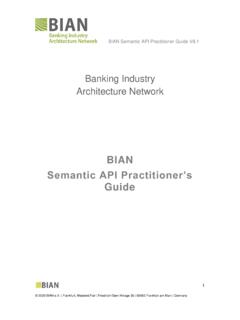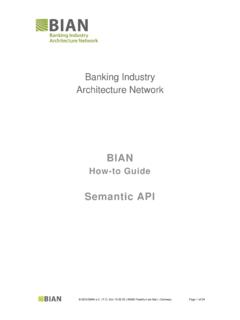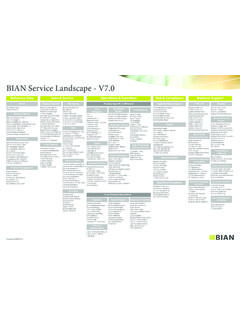Transcription of BIAN – PNC Open APIs for Banking
1 bian PNC open apis for BankingCapstone Project at Carnegie Mellon UniversityMark Grobaker, Arashdeep Kaur, Chaitanya Kommuru Wenting Tao, Pallavi Thakur10th May 20172 ContentsExecutive Summary 03 Acknowledgements 03 Project Objectives 05 Objective 1: Comply with PSD2 05 Objective 2: Demonstrate a solution built on bian , IFX, and PNC 05 Project Methodology 07 PSD2 Use Cases 07 bian s Contribution 09 IFX Messages for PSD2 11 Comparing IFX and ISO 15 Interacting with PNC 16 Solution architecture 17 Implementation 19 Introduction and file description 19 Choice of HTTP method for RESTful API 20 Code Walkthrough 21 Using our apis 25 Conclusions and Recommendations 27 Lessons Learned 29 Suggestions for Future Work Standards and Frameworks 29 Suggestions for Future Work Development Work 31 Appendix 3203 This was a joint project between masters-level graduate students at Carnegie Mellon University s Heinz College, and stakeholders at PNC Bank, bian ( Banking Industry Architecture Network)
2 , and IFX (International Financial eXchange).We demonstrate a working proof of concept for open apis in Banking , in compliance with the European Commission s PSD2 financial regulation groups can build on these efforts to ensure PSD2 compliance at their respective financial would like to thank all those who contributed to the success of this project. CMU Professor Mike McCarthy was our adviser, and guided us in our approach to the problem. Our client teams also provided valuable information and feedback as we progressed through the project. Our thanks go to: Hans Tesselaar and Guy Rackham of bian ; Rich Urban of IFX; Chad Ballard, Mike Downs, Laura Ritz, and Elesha Schulze of PNC; and Ganeshji Marwaha, Chamindra De Silva, Pubudu Welagedara, and Chinthaka Dharmasiri of Virtusa Polaris, consultants to Summary0405 Objective 1: Comply with PSD2 The first goal of the project was to create a working proof of concept for open apis for Banking , in compliance with PSD2. PSD2 is a financial regulation document that applies to banks and financial institutions in the European Union.
3 This regulation was published on January 13, 2016, and will go into effect for banks on January 13, reason PSD2 seeks to have banks create these apis is so that third parties can use them to interact easily with the bank. There are two primary use cases required by PSD2. Banks should enable third parties to: (1) submit peer-to-peer payments to the bank, and (2) check account balances. Both of these capabilities are to be enabled via openly accessible PSD2 requirements, no fees should be charged to third parties for these services. Further details on PSD2 can be found in a whitepaper published by Deutsche Bank 2: Demonstrate a solution built on bian , IFX, and PNCThe second goal of the project was to use principles from bian and IFX to build a solution. This solution was built to interact with PNC, but could be adapted to any provides architectural principles designed to guide technology implementations at financial institutions. IFX provides a messaging standard, again, designed specifically for financial institutions.
4 bian and IFX were interested in producing a prototype to show how their standards, designed specifically for financial applications, could be combined to produce a functioning Objectives 1. is a top ten US bank and a partner with bian in several other initiatives. Because of their interest in furthering the work of bian , they offered to make a test environment accessible to the CMU development were to use bian frameworks at a high level to guide the implementation of a message exchange. The messages themselves would be structured according to IFX format. We chose the scenarios we wanted to model based on the requirements of PSD2, which will be discussed further 1. Left: Sample parties interacting with open apis . Right: standards used to structure the messages to be returned from the bank, in this case, PNC MethodologyPSD2 Use CasesWe begin by examining the use cases of PSD2. Per PSD2, banks should enable third parties to: (1) submit peer-to-peer payments to the bank, and (2) check account balances.
5 We produced the below diagrams to model these use figure 2, we model a peer-to-peer payment. In this case, Ben Roethlisberger wants to make a payment to Amazon. (Since we were working from Pittsburgh, we made examples involving star players from the Pittsburgh Steelers!) Ben has an account at PNC, and Amazon has an account at Chase. In order to initiate the payment, Ben fills out a form on his third party provider (TPP) to request a payment to be sent. In this case, we have displayed Venmo as an example TPP. Venmo then sends a message to PNC requesting the transfer. PNC transfers the money to Chase, and the funds are now available for Amazon to could just as easily have been from Ben to another consumer, rather than from Ben to a business. Either one would qualify for this PSD2 use case of sending a payment.(As a side note, services like Venmo do not currently exist in Europe for payments between EU countries. Even in the US, Venmo works by using the ACH system, which takes up to 3-5 days for processing.)
6 Using open apis would enable instantaneous transfers.)The area in the red dotted box is the one we will be focusing on for our prototype; that is, we developed the messaging between the TPP and the above figure shows a model of checking account balances across multiple banks. In this case, Antonio Brown requests his TPP, Mint, to monitor balances from his two accounts, PNC and Bank of America. Mint would automatically generate balance requests to PNC and Bank of America on a regular basis (daily or more frequently, depending on the TPP configuration).The banks would then respond to this message by providing their respective balances to Mint. (Services such as Mint do not currently exist in Europe.) Again, we wanted to build just the part boxed in red: the communication between the TPP and the 3. Check account balances, second use case specified in PSD2. Antonio Brown gets his balances from PNC and Bank of 2. Peer-to-peer payment, the first use case specified in PSD2.
7 Ben Roethlisberger sends payment to relationshipMandatedFinancial ReportingMandated by Payee09 bian s ContributionWe had a number of calls with Guy Rackham, bian Lead Architect. He explained to us the work that his organization has done. In particular, he referred us to the bian Semantic API How-To Guide, an architectural document he helped of the main components of this document is the Semantic API Selection Framework, which is shown below. The framework helps the developer or architect to ask all right questions that need to be asked before developing a solution. (Full explanations of how to use this framework are available in the bian Semantic API How-To Guide and are not replicated here.) This framework would prove helpful in structuring our solution to the needs of this introduction, Guy provided us with PSD2-specific guidance, by giving us an overview of the different steps he saw as necessary to carry out the use cases of PSD2: send payment and check balance.
8 We took those steps and reformulated them into the diagram shown below in figure 6. This sort of guidance showed the kind of value-add that bian can bring. IFX and other messaging standards bodies are more concerned with the messages themselves, not the business use cases. A group like bian was helping in explaining what all the different steps needed to be for the use cases. Then we were able to implement some of these steps using IFX in our solution. As shown in the steps in the figure below, in the send payment case, the consumer (PSU, the payment service user) first registers the TPP (third party provider). Then he requests the TPP to send a payment. The TPP authenticates itself with the bank, and finally instructs the bank to make the payment. Figure 4. bian s Semantic API Selection Framework10In the check balances case, once again the PSU first registers with the TPP, and then asks the TPP to check balances. After an authentication step, the TPP retrieves the balances from the bankOf these steps, we needed to determine which would be in or out of scope for our project.
9 The registration would be out of scope, as that pertains to user registration for the TPP only (your login credentials for Venmo, Mint, etc). However, the request, authentication, and execution would all relate to our project and were potentially in scope. Our work on these steps is discussed further below. Furthermore, we mapped all these steps from PSD2 using the bian Semantic API How-To Guide. The results of this exercise can be found in the appendix of this report. At this point, we now needed to learn more about the kind of messages would send, especially in the execution step. We turned to our partners at IFX to learn more about the messaging format they could 5. PSD2 use cases: peer to peer payment (left), and check balances (right)RequestAuthenticationExecutionPay ment initiation Service ProviderAccount Information Service ProviderRegistrationPSD2 Peer to Peer Payment11 IFX Messages for PSD2 Rich Urban, president of IFX, provided an introduction to IFX over a number of phone calls with the CMU team.
10 In particular, he indicated the right IFX message formats that would apply to each of the use cases we had in mind. For sending a payment, he indicated that we should use the IFX message called PmtSendRq, which would be acknowledged by the PmtSendRs message. For checking balance, we were to use the BalInqRq, which was acknowledged by BalInqRs. All IFX documentation was available online at The most important part of the site is BMS, which is short for business messaging specification . The BMS section of the site can be searched for thousands of available message specifications. In our case, there were only four messages that we needed to use, as listed above. We were also able to download the JSON for these messages from a Swagger utility on the website. There were a number of optional fields contained in each message, and we chose not to use them in our implementation. To remove these optional fields, we had to manually go through the JSON and strip them out. As a small feedback to IFX, we would recommend enabling JSON exports that have the optional fields already removed.






